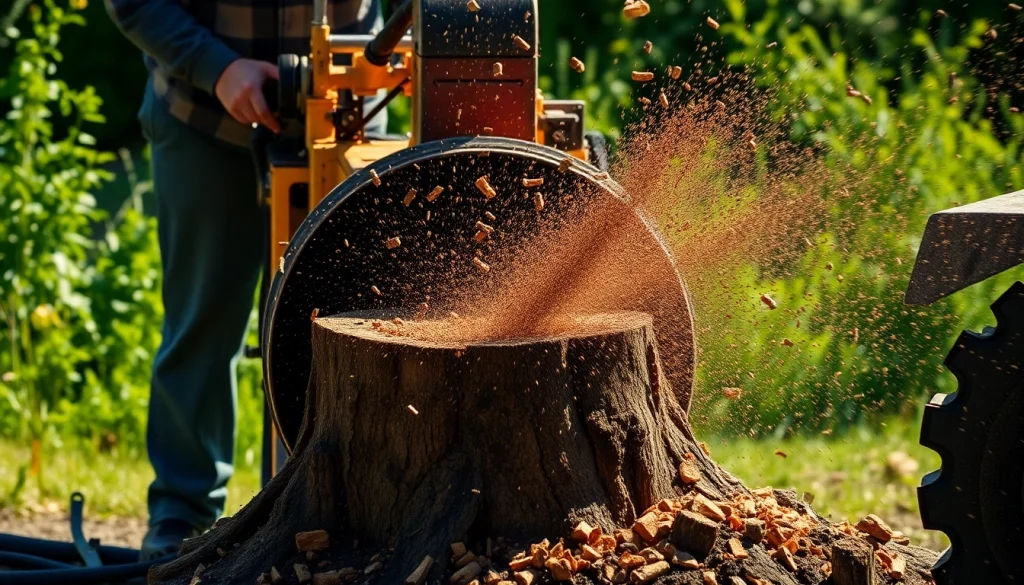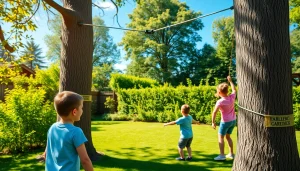
Understanding Stump Grinding Services
When dealing with a tree removal project, the work isn’t truly done until the stump is addressed. Stump grinding is a popular and effective solution for removing tree stumps while minimizing the disruption to the surrounding landscape. This stump grinding service provides homeowners and property managers with a straightforward method to eliminate unsightly stumps and reclaim usable space in their yards.
What is Stump Grinding?
Stump grinding involves the use of a specialized machine known as a stump grinder, which shreds the tree stump into small wood chips. By grinding down the stump below the surface of the soil, the process allows for seamless landscaping without the presence of a lingering tree root. This service is distinct from stump removal, where the entire root system is extracted, which can be much more invasive and costly.
The stump grinder typically employs a rotating blade that can cut through the wood with precision, removing it bit by bit. This process can reduce the stump to a large number of wood chips that can either be recycled or disposed of, depending on the homeowner’s wishes.
Benefits of Stump Grinding Services
The popularity of stump grinding services can be attributed to a range of benefits they offer. Here are a few key advantages:
- Space Recovery: Once a stump is ground down, the area can be utilized for landscaping or new planting, effectively recovering space that would otherwise remain unusable.
- Enhanced Aesthetic Appeal: Stumps can be unsightly and detract from the beauty of a property. Removing them improves the overall appearance of the yard.
- Improved Safety: Stumps pose trip hazards and can obstruct lawn maintenance. Grinding stumps reduces these risks, making outdoor areas safer for families and guests.
- Reduced Pest Attraction: Left untreated, stumps can attract pests such as termites and beetles. Stump grinding eliminates the organic material that could harbor these pests.
- Increased Property Value: Maintaining your landscape by removing stumps can enhance your property’s appeal, potentially increasing its market value.
When to Consider Stump Grinding?
There are several scenarios in which homeowners should consider stump grinding:
- After removing a tree due to disease, decay, or damage.
- When a tree falls due to adverse weather conditions or structural weakness.
- If the stump is encroaching on pathways, driveways, or other essential areas.
- When planning new landscaping projects that require open space.
Choosing the Right Stump Grinding Service
Choosing the right stump grinding service can be a significant factor in ensuring a successful project. Here are some critical aspects to consider:
Key Factors in Selecting a Service Provider
- Experience: Look for a service provider with a solid reputation and significant experience in stump grinding. Experienced professionals are more likely to handle the job with expertise and avoid potential pitfalls.
- Insurance: Ensure that the company has liability insurance. This protects both the worker and homeowner in case of accidents or damages during the project.
- Certifications: Verify if the technicians are certified and trained in using stump grinding equipment, ensuring a high standard of work.
- Equipment: Modern and well-maintained equipment is crucial for efficient and effective stump grinding. Inquire about the machinery the company uses to do the work.
- Customer Service: Responsive, friendly, and knowledgeable customer service can be indicative of the overall quality of the company.
Comparing Prices and Services
Price can vary widely between different stump grinding service providers, so it’s wise to obtain multiple quotes. Look not only at the price but also what services are included:
- Are clean-up costs included in the quote?
- Does the price factor in the size and number of stumps to be removed?
- Are there additional charges for access to hard-to-reach areas?
By comparing these factors, you can make an informed decision that ensures you receive the best value for your money.
Reading Customer Reviews for Stump Grinding
Customer reviews are invaluable when it comes to assessing the quality of a stump grinding service. Look for reviews on multiple platforms, such as Google, Yelp, or the company’s own website. Pay special attention to:
- The consistency of positive feedback across various reviews
- Comments regarding the timeliness and reliability of the service
- Specific experiences mentioned about the work quality and cleanup efforts
Navigating reviews helps build a well-rounded picture of the potential service provider’s strengths and weaknesses.
The Stump Grinding Process Explained
Understanding the stump grinding process can demystify what to expect when hiring a professional service. Here’s a step-by-step overview:
Step-by-Step Overview of Stump Grinding
The stump grinding process consists of several key steps:
- Assessment: The professional evaluates the stump’s size, condition, and location to determine the most effective approach.
- Preparation: The area around the stump is cleared of debris and obstacles to ensure safety during grinding.
- Grinding: The stump grinder is positioned over the stump and the grinding commences, usually grinding to a depth of 6-12 inches below ground level.
- Cleanup: After grinding, the wood chips are typically raked and removed, though some homeowners may choose to repurpose them.
Tools and Equipment Used in Stump Grinding
A variety of specialized equipment is used in stump grinding:
- Stump Grinder: The primary machine used, which varies in size and mechanism depending on the job.
- Safety Gear: Professionals wear helmets, goggles, gloves, and protective clothing to prevent injuries during the grinding process.
- Chippers: These may be employed to further break down larger branch pieces into mulch.
Having the right tools enables technicians to work efficiently and safely.
Safety Measures to Consider During Stump Grinding
Safety is paramount during stump grinding. Essential safety measures include:
- Establishing a safe work zone, ensuring bystanders are at a safe distance.
- Wearing appropriate personal protective equipment (PPE).
- Ensuring the stump grinder is operated by a trained professional to avoid accidents and ensure effective machine use.
Maintenance and Care After Stump Grinding
Once stump grinding is completed, property owners should follow some steps to care for their landscape:
What to Do with the Residual Wood Chips
The wood chips produced during stump grinding can be managed in various ways:
- Reuse: These chips can be used as mulch in gardens or flower beds, providing nutrients and aiding moisture retention.
- Disposal: If the chips are not needed, they can be removed by the stump grinding service or disposed of at a yard waste facility.
- Composting: The chips can also be added to compost piles once mixed with other organic material, speeding up decomposition.
Landscaping Options Post-Stump Grinding
With the stump removed, this opens up numerous landscaping possibilities:
- Planting new trees, shrubs, or flowers in the newly available space.
- Creating garden beds or decorative features like rock gardens.
- Installing pathways or borders using landscaping stones or pavers.
Consider consulting a landscaping professional to craft a design that integrates well with the overall aesthetic of your property.
Long-Term Care for Your Yard After Grinding
To maintain the integrity of your landscape after stump grinding, consider the following:
- Regularly water newly planted areas to help them establish.
- Monitor for any signs of pests or diseases in surrounding trees and plants.
- Consider scheduling soil testing to assess nutrient levels post-grinding.
Common Challenges in Stump Grinding Services
Despite the effectiveness of stump grinding, certain challenges can arise during the process:
Addressing Tree Root Issues
With many trees, the root system extends significantly beyond the visible stump, which can complicate removal:
- Professionals may need to assess how deeply the roots penetrate and adjust their grinding approach accordingly.
- In some cases, additional measures such as root excavation might be necessary.
Dealing with Difficult Terrain
Ground conditions may pose challenges, especially in rocky or uneven landscapes:
- Stump grinders can be cumbersome in tight spaces or steep slopes, possibly requiring specialized equipment.
- Careful site assessment and planning can mitigate difficulties posed by the terrain.
Environmental Considerations in Stump Grinding
Stump grinding should also take into account the surrounding ecosystem:
- Wildlife habitats can be affected by tree removal; consider consulting environmental experts if necessary.
- Using environmentally responsible disposal methods for wood chips and debris can contribute positively to local ecology.






